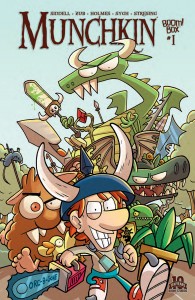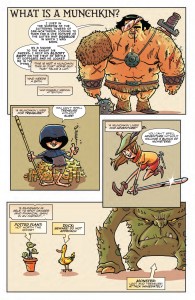By Davey Nieves
Munchkin #1

Writers: Jim Zub, Tom Siddell, John Kovalic
Illustrators: Mike Holmes, Rian Sygh, John Kovalic
Colors: Fred Stresing
Letters: Jim Campbell
Publisher: BOOM! Box
The world of table top card games is a universe in and of itself. Much like exploring space you have to be willing to come into contact with any life forms you discover. My sea crab nature prevents me from doing so but I can appreciate the cunning and strategy involved in crafting a game like D&D, Magic The Gathering, or Cards Against Humanity. Apparently I’m not the only one; BOOM! Studios BOOM! Box imprint decided to do a comic book series based on the popular card game Munchkin.
Originally a satire of fantasy roleplaying, the game has since taken on non-fantasy and non-gaming elements, and the new comic series is a direct reflection of that. For anyone that’s never played Munchkin; the game is more of a parody take on card gaming, only with a purpose. Kick open the door. Kill the monster. Steal the treasure. Screw over everybody you come in contact with. Welcome to the quirky world of Munchkin. The book features four stories set in and around the world of the game, featuring Spyke, Flower, and all the other characters, monsters, and settings players have come to love.
Let’s just talk about the best and worst of the stories found in this first issue, because there’s a fit for each. Jim Zub writes a great six page story dealing with one of the game’s most prominent themes, betrayal. One experienced character seemingly guides a noob through a dungeon as he’s simply trying to level up. The jokes in the story are sharp enough that you’ll ignore the “saw that one coming” ending. Tom Siddell’s “Humans Got No Class” story definitely lacks the punch that the others in the book capture. The story is about a group of players trying to lure their friend into joining the game only for the rug to be pulled out from under them. While it has its own charm, the punchline of the story just doesn’t make you laugh as much as the other tales did. Tom also writes a three page opening called “What is a Munchkin?” that’s hilarious.

For a book that has three different artist; the style feels universal and not one bit out of place in this cover to cover satire on gaming tropes. Mike Holmes, Rian Sygh, and John Kovalic each illustrate a story (sometimes two) and each capture necessary whimsy the sight gags need to keep the readers attention. While Rian’s work is probably the smoothest of the three none ever feel foreign compared to the others.
Overall Munchkin is a fun read for fans and non-fans alike, but any lasting appeal will only land with hardcore fans. Bonus, there’s even an exclusive Up A Level card for players that ships with the first print of every issue. BOOM! Box knows who they’re selling this book to and have designed it that way. If you already know and enjoy the world of Munchkin go pick this up.
If you remember the word munchkin as something uncle Jesse called Michelle on Full House then follow Dave on twitter@bouncingsoul217

A card game illustrated by Leo Espinosa? Duh! Yes, please! (Plus it’s an excuse to brush up on my Spanish.)
P.S. The other sets look great too!
(via studioespinosa - Food Olympics)

I’m all about video games in libraries. I have a Wii and a Playstation 2 at my library, and have been having gaming programs a few times a month since I started last summer. It is certainly fun and brings in the teens, but recently I decided to try something new: board games and card games. I called it Low Tech Gaming. The program had a good turnout and was so much fun, that I’ve decided to add it to the Friday afternoon rotation.
The games I used: Apples to Apples, Jenga, Chicopoly and chess. Several board game titles are available from Demco, which is where I purchased some of these. The others my library had. Click through for details of our gaming session.
I borrowed a chess set from our Children’s room. I was impressed by how many of the teens in attendance knew how to play and gravitated toward it on their own. It had more boy appeal than girl appeal in this group, but I also had more boys than girls at the program.
Chicopoly is a Monopoly game based on our town, Chicopee. Instead of real estate squares like Boardwalk and Park Place, it is populated with local businesses. The object is to get customers rather than houses and hotels. I’ve seen games like this for other towns. Maybe one exists for yours. It surprised me that this was so appealing to my teens, but, aside from a bit of complaining about the money, they knew how to play. Monopoly is a long game, so they didn’t end up finishing in our hour and a half program session, but they still enjoyed the game.
It was a little tough to get a game of Apples to Apples started because I was having trouble explaining it. Each player gets seven red card with nouns on them. For each turn there is a green card with an adjective on it. Players must use one of the cards in their hand to be described by that adjective. Each player takes a turn being the judge, who decides which noun fits the adjective best, usually based on humor. You end up with statements like: Godzilla is delicate. One boy summed it up nicely saying it was comparing stupid things to other stupid things, which worked for the group and got the game going.
The hit of the day was Jenga. You make a tower of groups of three blocks in alternating directions, the object is to pull blocks out of the tower without knocking it down. Two boys were calling it epic Jenga and creating the highest, most precarious towers they could. Their deep concentration over the pulling of each block was impressive and amusing. It drew an audience of some of the other teens in the room.
This was just a small sample of games. There are so many others that would work for this kind of program. There was a request for card games, so next time I’ll bring regular playing cards, Uno, and Phase Ten. I would also like to try out some of the more involved board games that I have played, like Settlers of Catan or Power Grid (or maybe even Arkham Horror, one of my favorites, but it’s quite time consuming). I often hear about new games from my friends, or from browsing the gaming sections in comic book stores. Another good resource is this blog: Library Gamer.
Something I particularly enjoyed about this program, which was different from our high tech gaming days, was all of the eye contact being made, between teens and with me. It was a new kind of connection. I felt like I got to know the participants better than I do when we’re playing video games.






